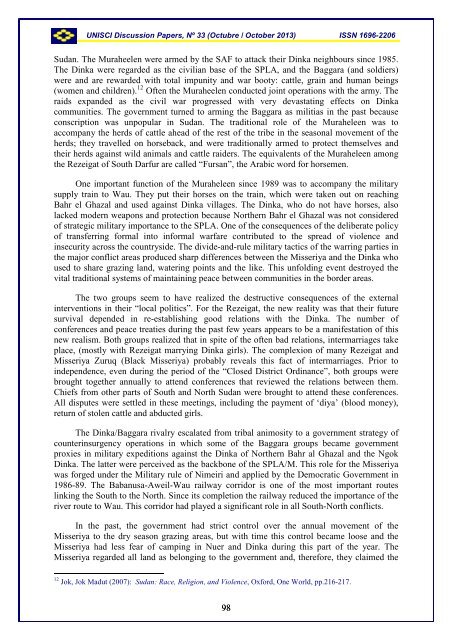UNISCI - Universidad Complutense de Madrid
UNISCI - Universidad Complutense de Madrid
UNISCI - Universidad Complutense de Madrid
Create successful ePaper yourself
Turn your PDF publications into a flip-book with our unique Google optimized e-Paper software.
<strong>UNISCI</strong> Discussion Papers, Nº 33 (Octubre / October 2013) ISSN 1696-2206Sudan. The Muraheelen were armed by the SAF to attack their Dinka neighbours since 1985.The Dinka were regar<strong>de</strong>d as the civilian base of the SPLA, and the Baggara (and soldiers)were and are rewar<strong>de</strong>d with total impunity and war booty: cattle, grain and human beings(women and children). 12 Often the Muraheelen conducted joint operations with the army. Theraids expan<strong>de</strong>d as the civil war progressed with very <strong>de</strong>vastating effects on Dinkacommunities. The government turned to arming the Baggara as militias in the past becauseconscription was unpopular in Sudan. The traditional role of the Muraheleen was toaccompany the herds of cattle ahead of the rest of the tribe in the seasonal movement of theherds; they travelled on horseback, and were traditionally armed to protect themselves andtheir herds against wild animals and cattle rai<strong>de</strong>rs. The equivalents of the Muraheleen amongthe Rezeigat of South Darfur are called “Fursan”, the Arabic word for horsemen.One important function of the Muraheleen since 1989 was to accompany the militarysupply train to Wau. They put their horses on the train, which were taken out on reachingBahr el Ghazal and used against Dinka villages. The Dinka, who do not have horses, alsolacked mo<strong>de</strong>rn weapons and protection because Northern Bahr el Ghazal was not consi<strong>de</strong>redof strategic military importance to the SPLA. One of the consequences of the <strong>de</strong>liberate policyof transferring formal into informal warfare contributed to the spread of violence andinsecurity across the countrysi<strong>de</strong>. The divi<strong>de</strong>-and-rule military tactics of the warring parties inthe major conflict areas produced sharp differences between the Misseriya and the Dinka whoused to share grazing land, watering points and the like. This unfolding event <strong>de</strong>stroyed thevital traditional systems of maintaining peace between communities in the bor<strong>de</strong>r areas.The two groups seem to have realized the <strong>de</strong>structive consequences of the externalinterventions in their “local politics”. For the Rezeigat, the new reality was that their futuresurvival <strong>de</strong>pen<strong>de</strong>d in re-establishing good relations with the Dinka. The number ofconferences and peace treaties during the past few years appears to be a manifestation of thisnew realism. Both groups realized that in spite of the often bad relations, intermarriages takeplace, (mostly with Rezeigat marrying Dinka girls). The complexion of many Rezeigat andMisseriya Zuruq (Black Misseriya) probably reveals this fact of intermarriages. Prior toin<strong>de</strong>pen<strong>de</strong>nce, even during the period of the “Closed District Ordinance”, both groups werebrought together annually to attend conferences that reviewed the relations between them.Chiefs from other parts of South and North Sudan were brought to attend these conferences.All disputes were settled in these meetings, including the payment of ‘diya’ (blood money),return of stolen cattle and abducted girls.The Dinka/Baggara rivalry escalated from tribal animosity to a government strategy ofcounterinsurgency operations in which some of the Baggara groups became governmentproxies in military expeditions against the Dinka of Northern Bahr al Ghazal and the NgokDinka. The latter were perceived as the backbone of the SPLA/M. This role for the Misseriyawas forged un<strong>de</strong>r the Military rule of Nimeiri and applied by the Democratic Government in1986-89. The Babanusa-Aweil-Wau railway corridor is one of the most important routeslinking the South to the North. Since its completion the railway reduced the importance of theriver route to Wau. This corridor had played a significant role in all South-North conflicts.In the past, the government had strict control over the annual movement of theMisseriya to the dry season grazing areas, but with time this control became loose and theMisseriya had less fear of camping in Nuer and Dinka during this part of the year. TheMisseriya regar<strong>de</strong>d all land as belonging to the government and, therefore, they claimed the12 Jok, Jok Madut (2007): Sudan: Race, Religion, and Violence, Oxford, One World, pp.216-217.98
















